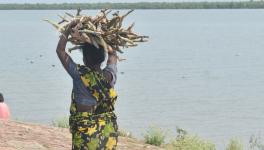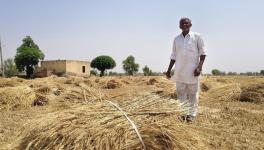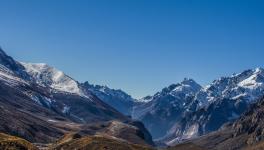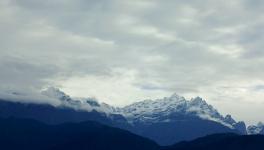Kashmir: In Kupwara, Native Fish Disappear With Changing Climate

Nallah-e-Mawar no longer sustains traditional fishing livelihoods (Photo - Adnan Rasheed)
Kupwara, Jammu and Kashmir: Atop the snow-capped Kazinag Peak at an elevation of 15,007 ft is the Kazinag Spring and Satkhol Nag, which feeds Nallah-e-Mawer that winds through Kupwara district. Once a vibrant water body, Nallah-e-Mawer now resembles a threadbare stream.
“The water level is so low that one can barely pass through with shoes on. How can we expect to find fish in such shallow water? I am fed up with this job. It is a waste of effort and time,” fretted Showkat Rasool Wani (29) from Handwara, a town in Kupwara district.
“For the last three years, I have been catching only 1.5 kg of fish per day. Five years ago, this was more than five kg in just a few hours,” he added.
“I cannot bear to see this low water level. My childhood and dreams are intertwined with it… Even a decade ago, it was a good time as Nallah-e-Mawer had ample water. I used to catch more than five kg of fish in a day," said Mohammad Raja Akbar (40), a former fisherman from Mawer in Kupwara. “Due to high shortage and low yield, I started a shop in my locality where I sell everyday items and some agricultural products.”

(Left) Raja Akbar, former fisherman from Mawer talking about low yield and (right) Dr Chalkoo explains the ideal environment for Kashir gaad (Photo - Sourced by Khursheed Ahmad Shah, 101Reporters)
Locally known as Kashir gaad, Schizothorax (snow trout) genus of fish comprises species such as Schizothorax niger (ael gaad), Schizothorax esocinus (chirru), Schizothorax labiatus (chush), Schizothorax curvifrons (satter gad) and Schizothorax plagiostomus (khont). “They are no longer found in the upper reaches of Nallah-e-Mawer due to low water levels. They survive only in the lower belts where some water remains,” Dr Salman Rauoof Chalkoo, Assistant Director of Fisheries, Kupwara, told 101Reporters.
The primary fish species now found in Nallah-e-Mawer are rainbow trout (Oncorhynchus mykiss) and brown trout (Salmo trutta). Rainbow trout inhabit the lower-lying areas of the stream. As a sport fish, it tends to move against the current, always striving to reach higher elevations.
“Various species of Schizothoracinae [snow barbels] also inhabited Nallah-e-Mawer once. We also had Glyptothorax sp. and Triplophysa sp., which were not commercially important. They inhabited creeks, the areas where stream water subsides and collects, as in the case of drainage channels. All these are no longer present in this river due to climatic changes,” noted Chalkoo.
Across North Kashmir, fishermen have observed a drastic reduction in their daily catch of Schizothorax, with some reporting an 80% decline — from eight to 10 kg per day to just one kg. Several factors, such as habitat destruction, water pollution and invasive species, have turned Nallah-e-Mawer, the main tributary of River Pohru, into a lifeless waterbody, but the primary drivers are climate change and anthropogenic pressures. As a result, species diversity has decreased by 60 to 70%.
While everyday consumption has shifted, cultural traditions still influence fish choices during important events. Despite low availability, there is specific demand for Kashir gaad during traditional festivals such as syundar and aqiqah.
“Over 10 years ago, (suppose) the local fish markets had around 100 kg of fish available each day suppose but now it has reduced to only 20 kg,” Farooz Ahmad Bhat, Chief Scientist and Dean, Faculty of Fisheries, Sher-e Kashmir University of Agriculture Sciences and technology of Kashmir (SKUAST-K), told 101Reporters. With the decline in Catch Per Unit Effort (CPUE), the supply of locally caught fish has decreased. As a result, people now rely more on farmed and imported fish for their daily meals.
Once a lifeline for nearly 160 families, Nallah-e-Mawar no longer sustains traditional fishing livelihoods. Families have been forced to turn to agriculture, daily wage labour, small businesses and traditional handicrafts to survive. However, Chalkoo noted that this shift is not just a consequence of ecological destruction, but a reflection of the social stigma surrounding the struggling fishing trade.
The unwelcome human footprint
One main anthropogenic factor affecting Nallah-e-Mawer is illegal sand mining from the river for two decades, which continues even now with hand tools. This activity disrupts the natural migratory path of fish that move from lower to the upper stretches of the stream. “Fish rely on biological and chemical habitats for survival, and their migration is possible only when there is an adequate water supply,” said Aatif Qayoom, a prominent environmental journalist in Kupwara.
"Fish sense their surroundings through their lateral line system, which help them navigate towards suitable feeding and breeding grounds. However, illegal mining has deepened the streambed, reducing the overall water level. This decline in water volume disrupts the breeding and feeding habitats, ultimately threatening their survival," he added.
When the government signs the e-auctioning agreement, a Letter of Intent is executed with the bidding stakeholders after consent from the line departments.
“All of these departments, including the flood control and irrigation departments, issue conditional no-objection certificates in writing that no heavy machinery will be allowed in the auctioned areas. The extraction limit is capped at one metre, a restriction that heavy machinery cannot meet. However, contractors often exceed this limit by extracting up to three metres. Similarly, the absence of adequate checks and balances allows contractors to expand the extraction area to two to three hectares,” Chalkoo said, adding that mining reduces water levels and high temperature reduces the oxygen level in water.
A social and environmental activist from Handwara, Advocate Mir Imran pointed to the widespread deforestation in the river’s catchment area, unregulated encroachments and excessive water extraction. “If these environmental challenges remain unaddressed, the region faces an impending water crisis that could alter its ecological and socio-economic landscape,” he warned.
But it’s climate change that has so far had the most insidious effect on the native fish population.
“Reduced glacier influx, rising temperatures, erratic precipitation, and altered hydrological cycles have affected Schizothoracinae fish species in Nallah-e-Mawer. Glacier retreat has led to diminished stream flow, causing lower water levels, higher temperatures and decreased oxygen availability, making the habitat unsuitable for cold-water fish. Increased siltation from unpredictable rainfall patterns, habitat degradation due to changing its dynamics, and prolonged dry spells have further disrupted the aquatic ecosystem, leading to the disappearance of these species,” Chalkoo noted.
Over the last few years, there has been very low snowfall, higher precipitation instead of snowfall, and higher temperatures in summer, triggering faster melting of glaciers and snow. This has resulted in early high-water discharge due to higher temperatures and subsequent dryness of rivers during the summer and beyond.
This isn’t just a seasonal fluctuation,” said Mukhtar Ahmad, Director of the India Meteorological Department in Srinagar. “What we’re witnessing is a long-term shift in climate. With warmer winters and declining snowfall, our water sources are under serious threat — affecting everything from farming to drinking water.”
“This phenomenon alters the phenology of the ecological niche of the watercourses — particularly in terms of water quality — and leads to changes in fish behaviour and physiology. It also alters the availability of food for the fish in these watercourses. The changing water discharge, along with deteriorated water quality and habitat, affects the occurrence, abundance and distribution of fish, ultimately reducing their numbers,” explained Chief Scientist Bhat.
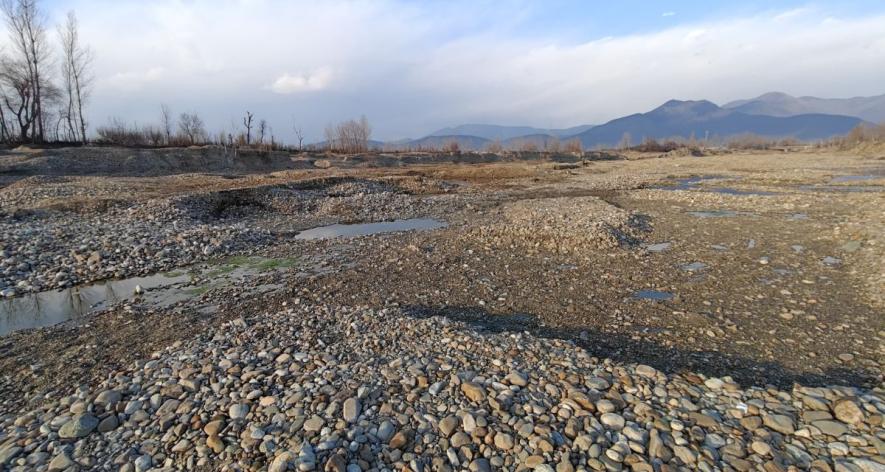
Over the last few years, there has been very low snowfall, higher precipitation instead of snowfall, and higher temperatures in summer, triggering faster melting of glaciers and snow (Photo - Khursheed Ahmad Shah, 101Reporters)
Native fish can benefit from research and policy support
Every year, the Jammu and Kashmir Fisheries Development Department replenishes various water bodies with thousands of carp and trout fingerlings, ensuring the sustainability of aquatic life and supporting local fisheries in the face of dwindling native species.
While kashir gaad and other native fish varieties have shown a decline in numbers over the last decades due to the change in water levels, water quality and food availability, exotic varieties like carps (major carps catla, rohu and mrigal, and minor carps grass carp, silver carp and common carp) have outnumbered the indigenous ones as the changing environment favours them, Bhat added.
Comparing the growth rates of carps and trout, Chalkoo said, “Common carp has a faster growth rate and is a prolific breeder, which keeps on breeding throughout the year and on very meagre natural triggers like photo period, increase in water temperature or increase in rainfall or water levels. The fecundity of the carp is around two to 2.50 lakh eggs per kg body weight, as compared to native fish with 40,00 to 45,000 eggs per kg body weight.”
However, in a significant step toward conservation, the faculty of fisheries at SKUAST-K has successfully developed technology for the seed production of Kashir gaad. This recent breakthrough has teased the potential for promoting native species as a more sustainable and ecologically balanced alternative with the right training and investment to make it economically viable for fishers.
“Research is ongoing to extend this breakthrough to other indigenous fish species. The fish seed produced through these efforts is released into major water bodies, including Dal Lake and River Jhelum, helping restore natural fish populations and maintain ecological balance," said Farooz Ahmad Bhat, Dean, Fisheries, SKUAST-K.
Also considering the significant losses experienced by the fishing community, the Government of India has extended support through the National Fisheries Digital Platform (NFDP) and Pradhan Mantri-Matsya Kisan Samridhi Sah-Yojana (PM-MKSSY).
Fishermen, fisherwomen, farmers, vendors, wholesalers, and helpers can register with NFDP to get an identity card and recognition. Eligible individuals will receive financial support of up to Rs 4,500, aimed at sustaining their livelihoods during challenging times. The accumulated amount of Rs 4,500 would be disbursed to enrolled beneficiaries by the respective states/UTs at the rate of Rs 1,500 per month for three months.
With an investment of over Rs 6,000 crore, PM-MKSSY is designed to provide 40 lakh micro and small fishing enterprises a formal identity, making it easier for them to access loans and credit. It also offers one-time incentives for aquaculture insurance and performance grants to boost business efficiency, improve product safety and quality, and ultimately create more jobs.
Khursheed Ahmad Shah is a freelance journalist and a member of 101Reporters, a pan-India network of grassroots reporters.
Get the latest reports & analysis with people's perspective on Protests, movements & deep analytical videos, discussions of the current affairs in your Telegram app. Subscribe to NewsClick's Telegram channel & get Real-Time updates on stories, as they get published on our website.













